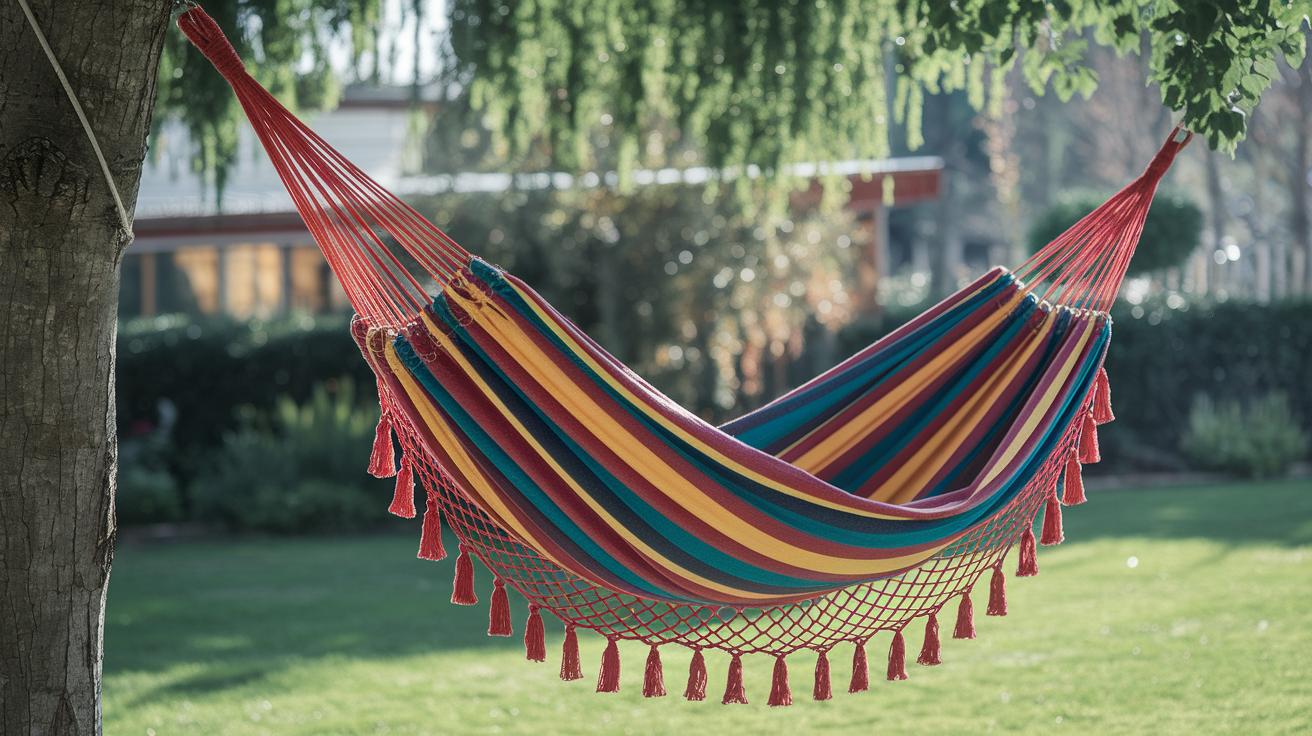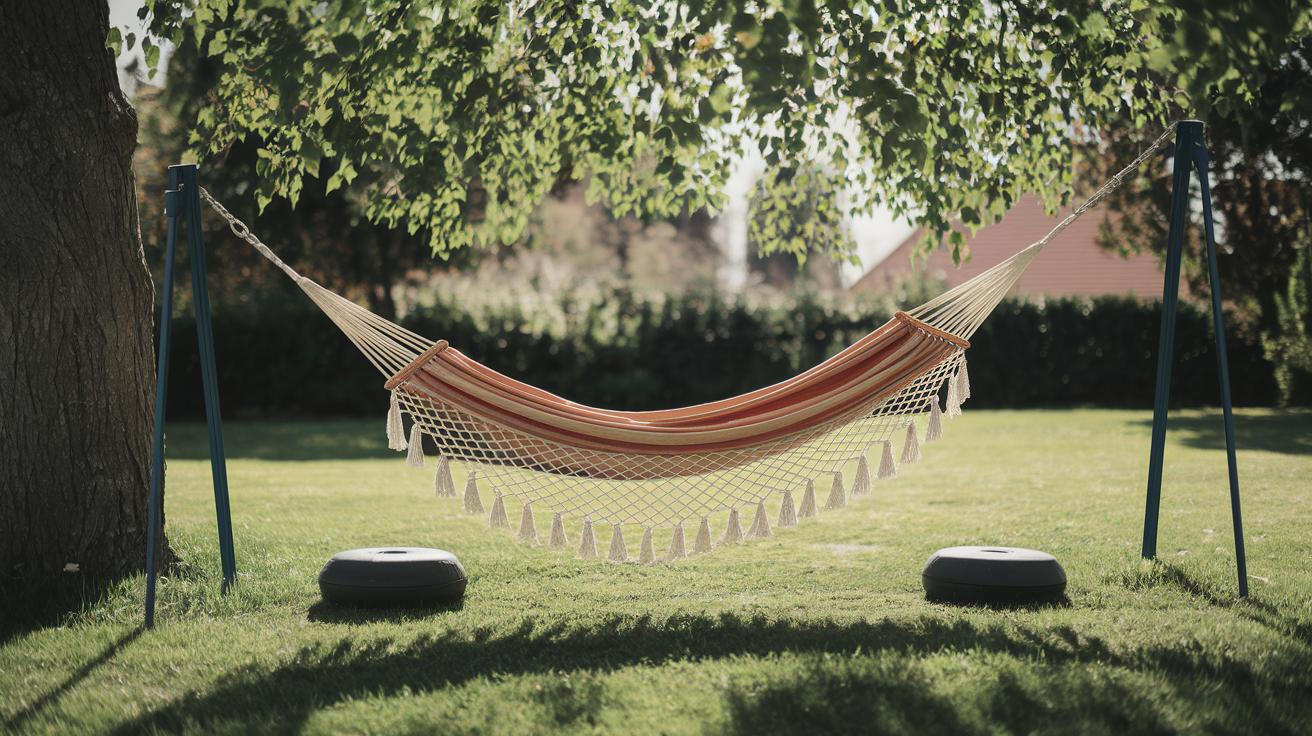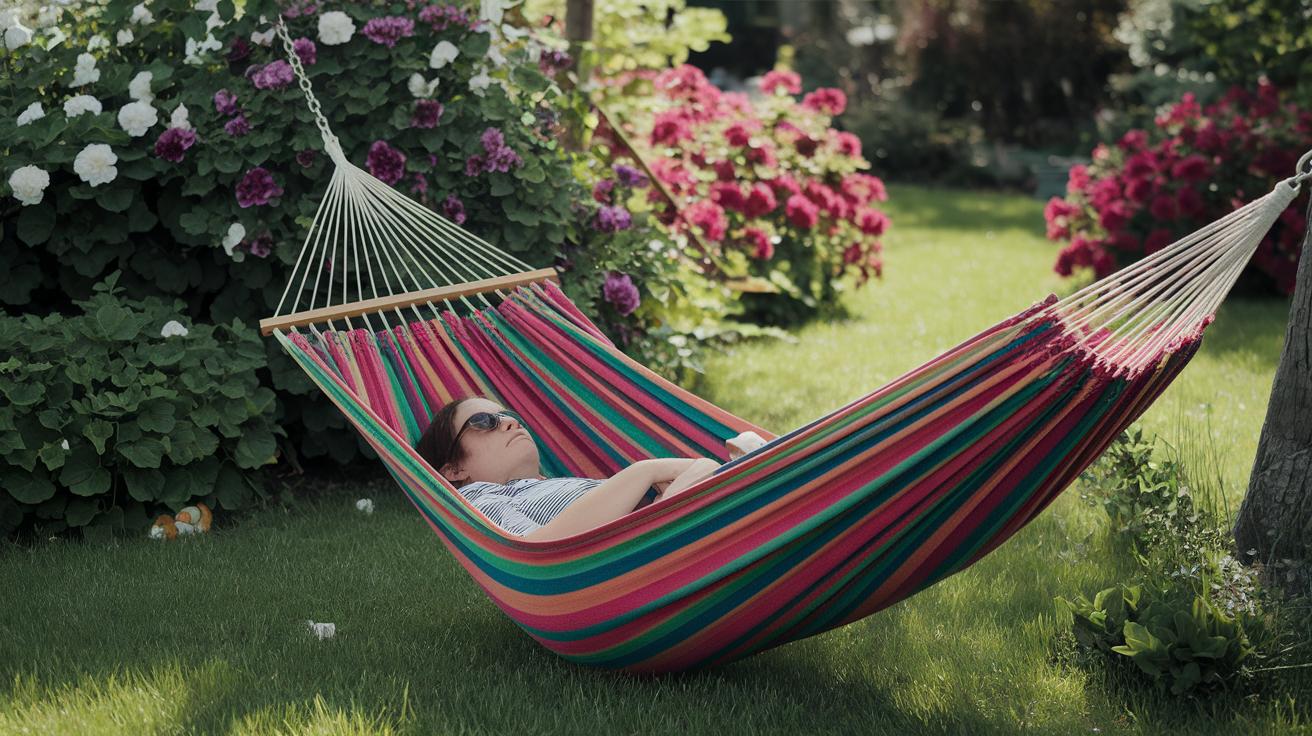Garden Hammock Weight Capacity Explained For Ultimate Safety
Ever dozed off in your backyard hammock under the warm sun and then shot upright thinking, “Is this thing going to hold me?”
Your hammock’s weight capacity (the max load it can hold safely) is like an invisible safety net. Most models come with a 20 to 30 percent buffer for those extra-floppy landings.
Oops. That extra wiggle room means no surprise tumbles. It keeps the fabric happier and lasting longer. And it brings pure backyard bliss.
In this post, I’ll share the real factors that affect your hammock’s load limit. So you can kick back under blue skies with total peace of mind.
Garden Hammock Weight Capacity Explained For Ultimate Safety
Your garden hammock’s weight capacity (the most weight it can hold safely) is how much weight it can hold without ripping or risking a fall. Manufacturers usually build in a safety buffer of about 20 to 30 percent (extra strength built in) so that a sudden shift or playful bounce doesn’t stretch it too far. It’s kind of like a secret cushion that saves the day if you flop over.
When you know your hammock’s load limit (maximum safe weight), the fabric and ropes stay happy. You can lie back, feeling the breeze, without worrying about a sudden tear. And it helps your hammock last longer since it’s not bouncing at its breaking point every time you hop in. By the way, my cat loves to nap with me, so I always factor in her extra weight.
Check the spec sheet (product info list) before you buy or hang your hammock. Add up your weight plus whatever else you plan to toss on there, your phone, a book, maybe a sleepy friend. Stick to that limit so you can sway safely under the sky and keep your backyard hangout going all season.
Ignore those numbers and you might end up with a sad sag or worse, a surprise crash to the ground. So always look for the load limit sticker or tag. Then you can settle in with total peace of mind.
Factors Affecting Garden Hammock Load Capacity

Have you ever flopped onto a soft cotton hammock on a warm summer day? Cotton feels cozy, but its tensile strength (the pull force it can take before stretching) is lower than polyester or nylon. Polyester and nylon resist stretching on busy swaying days, and stand up to sun and rain much longer. Blending in polyester bumps up both tensile strength and durability rating (how long the fabric resists wear), making it your first weight capacity factor.
Now let’s chat about ropes and knots. Thicker ropes carry more weight, plain and simple. If you tie a sloppy knot or use a weak splice method (joining rope ends), your hammock can slip mid-nap, been there, oops. A tidy knot in a sturdy rope spreads tension evenly and keeps sudden fails at bay. Rope thickness, knot quality and splice method are your next weight capacity factors.
Don’t overlook those little metal bits. Carabiners, hooks and chains all wear hardware weight ratings stamped right on them. That tiny label tells you how much load the metal can handle before bending or snapping, think of it like a safety promise. Even the snuggest hammock crashes if its hardware fails. So shear strength (resistance to cutting or sliding off) and hardware ratings form your third weight capacity factor.
And then there’s the stand, the backbone of it all. A well-built powder-coated steel frame holds up against weather and weight. Or choose a thick wooden A-frame for a charming, sturdy support. Spreading anchors wide avoids uneven pulls that lead to tears. All of these factors, fabric, ropes, hardware and frame, decide how much you and a friend can sway safely under the sky.
Test Protocols and Standards for Hammock Load Limits
You hang a hammock to relax in the warm breeze and watch fluffy clouds drift by. You want to feel safe in that gentle sway, right? So hammock makers run tests in a lab to check everything. They mimic your body lying still, a slow swing, or even playful ups and downs.
First up is the static load test. Um, they add a steady weight until the fabric or frame breaks. This shows the calm stretch limit of your hammock.
Then there’s the dynamic load test (when a machine bounces or swings the hammock). It mimics a restless nap or a pet jumping in for a cuddle. Oops, I meant a playful jump. You’d be surprised how much force it finds.
The fatigue cycle test lifts and drops weight thousands of times to spot slow wear in seams, ropes, and metal parts. In a drop stress test, they let a weight fall a few inches to test impact resistance. Each check follows industry rules that ask for a 1.2× safety margin above the rated capacity.
As they run these checks, technicians track the load deflection curve (how much the frame sags before the bars start to bend). They also measure each hook’s tensile rating (the pulling force it can take). That way you know the small metal link won’t stretch under your weight.
| Method | Description | Typical Failure Load |
|---|---|---|
| Static Load Test | Steady weight applied until fabric or frame fails | 1.2× rated capacity |
| Dynamic Load Test | Bounces and swings to mimic real moves | 1.3× rated capacity |
| Fatigue Cycle Test | Repeated lifts and drops to check wear | 1.5× rated capacity |
| Drop Stress Test | Weight drop to test impact resistance | 1.4× rated capacity |
So when you see these tests on your hammock tag, you can kick back and sway safe under the sky.
Typical Weight Capacities of Garden Hammocks

Have you ever settled into a hammock with your morning coffee and wondered if it can handle you plus your book? Lightweight models usually top out at 250 pounds (that’s about one person plus a few extras). They’re perfect for a quiet sway under a warm breeze.
Mid-range hammocks hold up to 350 pounds. That gives you room to stretch out or invite a friend along. And heavy-duty options support 450 pounds or more, so two pals can lounge side by side without a worry.
| Hammock Type | Weight Limit | Best For |
|---|---|---|
| Lightweight | Up to 250 lbs | Solo readers, light lounging |
| Mid-range | Up to 350 lbs | Stretching out, sharing with a buddy |
| Heavy-duty | 450 lbs or more | Two people, pets, or jumpy kids |
By the way, kids bouncing or your pup jumping in create dynamic load (extra force from movement) instead of static load (just sitting). Those playful moments can spike the weight well above the listed limit. So factor in every giggle and wag.
If you have little ones, look for child safety limits (weight ratings for toddlers and small kids, usually around 150 to 200 pounds). And don’t forget your fur baby, add your pet’s weight to the total or the hammock might sag.
Match your hammock to how you’ll use it. Solo readers do fine with 250-pound options. Couples, pet owners, or families with energetic kiddos deserve the peace of mind of a 400- to 500-pound capacity. Keep that number in mind, and you’ll sway safely all afternoon.
Installing Your Garden Hammock for Maximum Capacity
Pick anchor points you really trust, trees with thick trunks, sturdy posts, or solid ceiling beams. Imagine the rough bark under your hands when you wrap the straps around a tree (straps are wide to save the bark). Measure your hammock from end to end and space the anchors so the ropes sit at about a 30-degree angle. That’s the sweet spot for a comfy swing and balanced load.
No trees? No problem. Steel poles or a concrete wall can work just as well. Peek at how to hang a hammock in a garden without trees for some creative pole ideas. And if your yard slopes or is all rocks, check out garden hammock installation tips for uneven terrain. Adjustable ground anchors or blocks will keep everything steady.
Protect living anchors by using tree-friendly pads or wide straps around trunks. That padding spreads the weight and keeps the bark happy. You’ll thank yourself when your favorite oak is still standing strong.
Drilling in ceiling hooks takes care. Find a solid joist, not a rim joist or just plywood backing. For deck joist support, slip a heavy washer behind each hook eye to cut down pull-through. Use hooks rated for your hammock’s weight and tighten them to the torque specs in the manual. A torque wrench set to the right foot-pounds keeps hooks from loosening when you swing.
If a free-standing stand feels right, study its specs first. Make sure the stand’s weight rating matches or exceeds your hammock’s. Lay out all the parts, snug every bolt, then give them a retorque after your first sit-test. Loose hardware or an off-balance frame can shift when you climb in.
Getting suspension just right matters too. Use matching carabiners on each end, keep your ropes the same length, and hang them at identical heights. That equal setup spreads the load, no one side doing all the work. Aim for the center to hang about 18 inches off the ground so it’s easy to hop in or out.
Before you take a seat, give the hammock a slow test. Press down with your hands or toss a sandbag on it first. Then climb in gently. Check ropes, hardware, and anchor points every few months for signs of wear. And don’t forget to read the hammock’s tag for any special notes from the maker. Then lean back, sway softly, and enjoy the breeze.
Safety Margins and Guidelines for Garden Hammock Use

Have you ever climbed into a hammock under a shady tree? The soft sway and cool breeze can feel like a hug. But before you settle in, make sure your hammock can handle you and your gear. Add about 20-30% more capacity than your total weight. That gives it room to flex and keeps you safe.
Keep your weight centered and match both suspension points so each end sits at the same height. That way the load spreads out instead of straining one side.
I like to peek at my setup every few weeks. Look for these warning signs:
- Fabric sagging past its normal gentle curve
- Thinning spots, frayed threads, or tiny tears in the cloth
- Creaking or snapping sounds from ropes, straps, or hardware
- Knots or hooks that slip, twist too easily, or feel loose
If you spot any of these, tighten things up or swap in new parts. Then you can relax worry-free.
Environmental and Maintenance Factors That Affect Hammock Capacity
Have you ever left a favorite shirt out all summer? The bright sun’s ultraviolet light (UV light we can’t see) slowly breaks down the fabric, making it thin. Your hammock feels the same wear when it soaks up day after day of sun.
And rain, dew, and that muggy air (moisture wearing on the cloth) can leave the fibers soft and the metal bits starting to rust.
When nights turn cool and days heat up, some fabrics get stiff like a board and then stretch too much in the sun. That back-and-forth can change how your weight spreads across the cloth and ropes.
So you’ll want a simple check-up plan. Try giving your hammock a look every three months or after a big storm. Here’s what I do:
- Run your hand over the fabric and look for thin spots or faded areas that could rip
- Feel along the seams for loose threads or tiny gaps
- Give the hooks and carabiners a little wiggle to see if they wobble or feel rough
- Check metal frames or chains for rust, pitting, or green corrosion (that’s the stuff that eats away at metal)
- Tug gently on rope ends and knots to make sure they’re not fraying or coming loose
When you spot damage, swap out worn parts before you lounge again. Oops, I once ignored a few frayed ropes and paid the price, lesson learned!
Storing your hammock indoors during off-seasons or before a storm locks in its strength.
A quick fold and dry-off keeps both fabric and metal ready for your next backyard siesta.
Buying Guide: Selecting a Garden Hammock by Weight Capacity

Thinking of lazy afternoons under a leafy tree? Let’s pick a hammock that holds you up without a wobble.
Quick purchase checklist:
- Count your weight plus anything extra (like a pillow or playful pup). Then choose a hammock rated at least 30% more so it stays snug.
- Opt for a frame made of powder-coated steel (steel sealed to resist rust) or thick oak beams. These sturdy materials keep you swinging through sunny days and breezy evenings.
- Make sure it has a one-year warranty. That gives you 365 days of peace of mind against rips, rust, or sun fade.
- Feel the fabric’s weave before you buy. Slide your fingers along the threads to spot thin spots or loose knots.
Final Words
Jumping right in, we defined garden hammock weight capacity and noted those built-in safety buffers.
We then looked at how materials, ropes, hardware, and frame design shape load limits.
A peek at testing methods and typical capacity ranges set the stage for safe selection.
Installation tips showed how to hang with care, and simple maintenance steps will keep your hammock strong.
With garden hammock weight capacity explained, you can hang with confidence and enjoy long days of relaxation.
FAQ
What is garden hammock weight capacity?
Garden hammock weight capacity is the maximum load it safely supports before damage or injury. Manufacturers include a built-in safety buffer of 20–30% above the stated capacity for user protection.
Which materials affect garden hammock load capacity?
Material choice shapes tensile strength and fabric durability. Cotton, polyester and nylon have different ratings. Rope thickness, knot quality, carabiner shear limits and stand design also determine the hammock’s safe load.
How are hammock load limits tested?
Hammock load limits are tested using static load tests, dynamic load tests, fatigue cycle tests and drop stress tests. Standards require at least 1.2× the rated capacity to verify safety margins and durability.
What are common garden hammock weight capacities?
Lightweight hammocks support about 250 lbs, mid-range up to 350 lbs and heavy-duty versions 450 lbs or more. Multi-person designs often carry 400–500 lbs, though movement can raise peak loads.
How should I install a hammock for maximum capacity?
Proper installation uses secure anchor points spaced to match hammock length. Mount hooks into solid joists or posts with correct torque. Align suspension evenly on a free-standing stand to spread load and prevent hardware stress.
What safety margins should I follow to avoid overloading?
Follow a 20–30% safety buffer above total expected load for movement, gear and wear. Watch for overload signs like excessive sag, fabric thinning, creaking sounds or loose knots and hardware.
How do weather and maintenance affect hammock capacity?
UV exposure weakens fabric over time and moisture can degrade fibers or corrode metal. Inspect seams, hardware and fittings every few months and store indoors during storms or off-season to preserve load ratings.
How do I choose a hammock based on weight capacity and budget?
Compare manufacturer specs for capacity and built-in buffer. Budget models rate 250–300 lbs, mid-range 350 lbs, premium versions exceed 450 lbs. Assess frame quality, fabric and warranty before buying.







